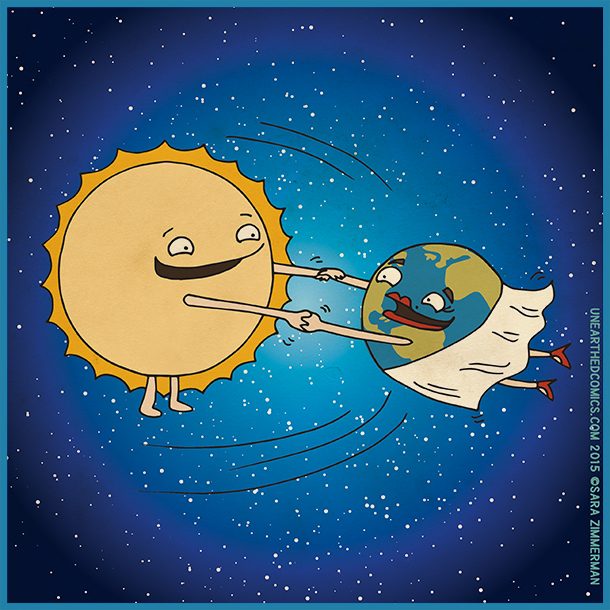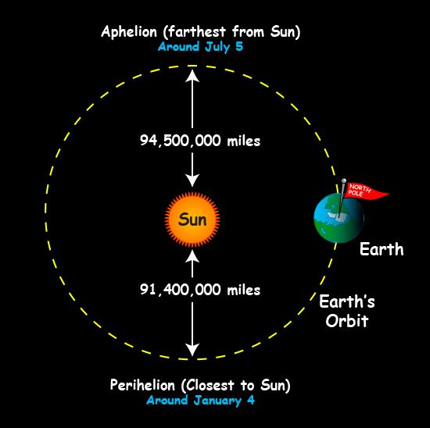

Via Sara Zimmerman at Unearthed Comics.
Planet Earth reaches a milestone today, as it swings out to aphelion, its most distant point from the sun. We reach this point on July 4, 2019, at 22:11 UTC. That’s 5:11 p.m. Central Daylight Time in the U.S. Translate UTC to your time.
Is it hot outside for you on your part of Earth right now? Or cold out? Earth’s aphelion comes in the midst of Northern Hemisphere summer and Southern Hemisphere winter. That should tell you that our distance from the sun doesn’t cause the seasons. More about that below.
Image top of post by Sara Zimmerman at Unearthed Comics. Thanks, Sara!

Image credit: NASA
The fact is, Earth’s orbit is almost, but not quite, circular. So our distance from the sun doesn’t change much. Today, we’re about 3 million miles (5 million km) farther from the sun than we will be six months from now. That’s in contrast to our average distance from the sun of about 93 million miles (150 million km).
The word aphelion, by the way, comes from the Greek words apo meaning away, off, apart and helios, for the Greek god of the sun. Apart from the sun. That’s us, today.
Looking for Earth’s exact distance from the sun at aphelion? It’s 94,513,221 miles (152,104,285 km) . Last year, on July 6, 2018, the Earth at aphelion was a tiny bit closer, at 94,507,803 miles (152,095,566 km).

The sun at aphelion appears smaller in our sky, as shown in this composite image. This image consists of 2 photos, taken just days away from a perihelion (Earth’s closest point to sun) in January, 2016, and an aphelion (Earth’s farthest point from sun) in July, 2017. The gray rim around the sun (actually the perihelion photo) illustrates that, as seen in our sky, the sun is about 3.6% bigger at perihelion than aphelion. This difference is, of course, too small to detect with the eye. Peter Lowenstein in Mutare, Zimbabwe – who captured the photos and created the composite – wrote: “Although taken 18 months apart, and a few days from the events due to adverse weather conditions, they show that there is an unmistakable size difference of the sun as viewed from Earth when it is closest at perihelion and furthest away at aphelion.”

This animation shows what’s also in the image above … the size difference of the sun between Earth’s perihelion (closest point) and aphelion (farthest point).
Here’s what does cause the seasons. It’s not a distance thing. We’re always farthest from the sun in early July during northern summer and closest in January during northern winter.
It’s a tilt thing. Right now, it’s summer in the Northern Hemisphere because the northern part of Earth is tilted most toward the sun.
Meanwhile, it’s winter in the Southern Hemisphere because the southern part of Earth is tilted most away from the sun.
Earth’s varying distance from the sun does affect the length of the seasons. That’s because, at our farthest from the sun, like now, Earth is traveling most slowly in its orbit. That makes summer the longest season in the Northern Hemisphere and winter the longest season on the southern half of the globe.
Conversely, winter is the shortest season in the Northern Hemisphere, and summer is the shortest in the Southern Hemisphere, in each instance by nearly five days.
Earth at perihelion and aphelion 2001 to 2100
Bottom line: Planet Earth reaches its most distant point from the sun for 2019 on July 4. Astronomers call this yearly point in Earth’s orbit our aphelion.
EarthSky astronomy kits are perfect for beginners. Order yours today.
Why isn’t the hottest weather on the year’s longest day?
Source:
https://earthsky.org/astronomy-essentials/earth-farthest-from-sun-for-year-in-early-july